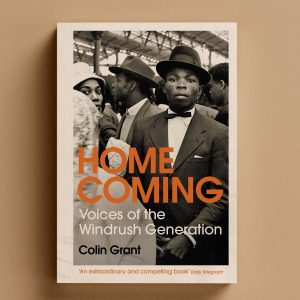New Books | Childhood in African literature
The framework of childhood, through representations of its images and memories, allows African writers to reimagine what family, ethnicity and nation mean within the diaspora.
Author:
22 March 2021

This is a lightly edited excerpt from Childhood in Contemporary Diasporic African Literature: Memories and Futures Past (Palgrave, 2020) by Christopher Ouma.
Diaspora childhoods: creating sublimated connections
One of the key experiences of African identities in the millennial age is migration. As previous chapters have demonstrated, contemporary African writers are not only “children of the oil boom” as Sefi Atta refers to them, they are also “children of the cold war”, a phrase used by Binyavanga Wainaina in his memoir to signal to the overarching political and economic context of these childhoods. In the aftermath of political independence, and at the height of the period of decolonisation in Africa, events that begun with the Biafran War in Nigeria ended the century with both the horror of the Rwandan genocide and a new hope represented by South Africa at the end of apartheid.
Perhaps the literary continuum created by this period could be allegorically marked by the titles of Tayeb Salih’s Season of Migration to the North on the one hand and Kole Omotoso’s Season of Migration to the South on the other. Indeed, modern African literature has articulated itself through various migrant figures. The figure of the “been-to” in some of the works of Chinua Achebe and Buchi Emecheta marked the literary imagination of the broad category contemporary African diasporas to which Paul Zeleza labels “diasporas of colonisation, decolonisation”. This figure constituted Africans who migrated during the colonial period in part to acquire imperial citizenship, and who (in the literary imagination of the mid-20th century) return on the eve of political independence to contribute to the decolonisation of the imperial civil service. Contemporary African writers form a latter part of this broader arc in Zeleza’s categories – specifically as diasporas of “the era of structural adjustment programmes (SAPs)”.
However, while Zeleza cautions against the danger of a limitless scope (for any kind of migration) in relation to the concept of diaspora, we can argue that contemporary African literature has over the past two decades congealed into a diaspora of imagination. Taken together, contemporary African writers share the “historical conditions and experiences that produce diasporic communities” – as “children of the postcolony” and in this case the SAPs, as well as the consciousness and awareness of themselves as part of a collective of “real and imagined genealogies and geographies”. So, if Ike Oguine’s Obi in A Squatter’s Tale inaugurates the literary figure of the millennial African immigrant into the process of (dis)identifying as part of a broader Nigerian-American/African diaspora, Chimamanda Adichie’s Ifemelu in Americanah can articulate (dis)continuities using the category “Black” between and among various processes of being diasporic, of diasporisation and of actually becoming part of the African diaspora in the US.
Related article:
These (dis)continuities mark the evolving dynamics of the categories of nation, ethnicity and diaspora in the contemporary imagination of African identities. Obi and Ifemelu embody the imaginative space that fills up contemporary African diasporic experience and the production of its various migrant identities. However, they also belie a much broader and multidirectional framework of diaspora and diasporic identification. In this sense then Zeleza cautions against the dominant Anglophone Atlantic framework of thinking through these diasporic experiences, and their connection to Euro-American forms of cultural imperialism. Like Brent Hayes Edwards’ notion of the “hemispheric limit” as a critique of Paul Gilroy’s “Black Atlantic” formulation (more on this soon), Zeleza invokes African diasporas of the Mediterranean and of the Indian Ocean, arguing for “decentralising the Atlantic”.
Contemporary African writers contribute to a very dynamic literary imagination of the African diaspora. While some of them would have spent their entire childhood in the continent and their adult lives elsewhere, some spent a fraction of it and left. Others considered part of this group would have been born to first-generation immigrant parents. Meanwhile, others would have migrated as full-grown adults. The diverse and complicated connection between childhood experiences, migration and the concept of the African diaspora is the subject of this chapter. These experiences allow us to engage the concept of diaspora as “a process, a condition, a space and a discourse” which is at various moments “made, unmade and remade” while generating “contentious ways in which it is studied and discussed”.
Related article:
Contemporary African writers have responded to these processes, conditions and experiences differently, and have generated a discourse about the visibility of Africa in the imagination of the world, in ways that speak to experiences of migration in this millennial moment, and how they redefine African and African diasporic identities. In their narratives, we can sketch connections between memories, images and figures of childhood and subsequent re-articulations of diaspora identities. These contemporary experiences of migration have generated diverse narratives that make claims across the broad spectrum of African diasporic identity. Adichie’s use of the term “Black” in Americanah is fraught with national, ethnic, gendered, classed and racialised differences in the American context. However, we see Yaa Gyasi’s Homegoing reverting to a more genealogical framework, broadening the spatio-temporalities of “Blackness” to make different political claims about what “Black” might mean in this contemporary moment. Both Adichie and Gyasi’s texts make for the dynamic conceptualisations of the African diaspora, particularly foregrounding gendered experiences of diaspora. Or if we consider Chris Abani’s The Virgin of Flames as invoking a queer valence to the category Black (with the protagonist eponymously named), then we expand the diversity and multi-dimensionality of these narratives and their potential contribution to the concept of the African diaspora in its contemporary iterations.
Moreover, if we also take heed of the risk of falling into the “American vanguardism” in the intellectual history of the concept of diaspora, we generate greater diversity by shifting our frames to other intellectual geographies – away from the American inclined North Atlantic. For instance, while Brian Chikwava’s Harare North invokes the huge presence of a Zimbabwean diaspora in the UK, Helen Oyeyemi’s The Opposite House broadens its historical canvas to Central and South America. Moreover, how might we interpret the diasporic spatio-temporalities within the African continent itself? For example, Wainaina’s memoir One Day I Will Write About This Place draws on a cultural pan Africanism through its invocation of a form of “stereomodernism”. In South Africa, Yewande Omotoso’s Bomboy or The Woman Next Door invoke South Atlantic geographies that connect South Africa to Nigeria and then to the Caribbean. Or, take Shailja Patel, East African poet of Indian descent whose work speaks to both an East African Indian Ocean and an Atlantic framework of diasporic identity. The examples above merely demonstrate the complexity of articulating migrant experiences through any specific framework of the Atlantic diaspora. While some of these writers create narratives that make claims to specific historical diasporas, others move in between historic conceptions of diaspora to those that are informed more closely by the category “postcolonial”. Yet again, there are distinctions between the North and South Atlantic articulations of diasporic experiences.
Related article:
There are also narratives that draw closer connections between continental pan Africanism and the broader concept of the African diaspora. So we might therefore want to take heed of not only Zeleza and Edwards’ engagements “beyond the Black Atlantic”, but also Michelle Wright’s argument about reading beyond the Middle Passage as an epistemological framework. In her book Physics of Blackness, Wright argues that making the Middle Passage as a foundation to definitions of “Blackness” of the African diaspora, relies on a linear logic of space and time which often fails to register the “epiphenomenal spacetime” of marginalised groups like Black women, Black queers as well as the entire category that Zeleza classifies as the “contemporary diasporas” – diasporas that do not have immediate genealogical connections with the Middle Passage. Wright argues that a more complex yet inclusive and non-hierarchical framework would be one that understands Blackness as “the intersection of constructs” that can locate collective Blackness historically as well as in the moment in which it is being imagined. Wright emphasises reading against the grain of linear timelines and how they organise space and identity formation. Her conceptualisation of “the now” of Blackness, of theorising the African diaspora deconstructs the causal logic of the Middle Passage and Black Atlantic framework. She says, “no moment one experiences depends directly on a previous moment in order to come into being”. In this way, she argues for the multiple and multidirectional temporalities that should productively frame any theorisation of the African diaspora, especially in this contemporary post-war context. In some ways, Wright’s argument is partly consistent with Edwards’ analysis of the “uses” of the term diaspora, which he says should force us to “consider discourses of cultural and political linkage only through and across difference”. These differences (nation, class, gender, sexuality, language, ethnicity), which Wright articulates as generating different spatio-temporalities, are read by Edwards as aspects that “resist translation” while leading to the fractal logics that attend to dominant readings of the Black Atlantic as the African diaspora. Using the metaphor of a “table with legs of different lengths”, Edwards advocates for the discursive “propping up” of the concept of African diaspora in ways that should always consider the differences as “a necessary haunting”: that any articulations of diaspora should always already structure these differences in their frameworks.
Edwards advances an argument that frames Black diaspora as “that which cannot be transferred or exchanged, the received biases that refuse to pass over when one crosses the water”. He emphasises that any articulations of diaspora will have to be approached through strategies that provide prosthetic tools for the purposes of mobilising a political Blackness. In this way such articulations will rely on the logic of strategic contingency rather than the strategic essentialism that Wright and Zeleza also read in the Middle Passage and Black Atlantic frameworks. Contemporary African literature presents narratives that interrogate these frameworks. The migrant childhoods presented in many of these narratives have generated revisionist readings of the concept of diaspora in this contemporary and millennial age. Migrant childhoods particularly present genealogical and generational logics of engaging with diasporic identities.
In this sense then narratives such as Sefi Atta’s collection of short stories News from Home present scenarios that complicate the blurred lines between first and second-generation affiliations and acculturation to the historical diasporas. These narratives raise questions about the when and where of the Black diaspora while asking for the epiphenomenal spacetime that Wright argues for. In what moments, for instance, do second-generation immigrants of African descent affiliate with the historical diasporas of the North and South Atlantic, without putting to erasure their ethnic and national connections with the continent? Often migrant childhoods present these scenarios. Darling in NoViolet Bulawayo’s We Need New Names, or Dike in Adichie’s Americanah embody experiences that speak to these moments, where Blackness is mobilised both for constructivist and phenomenological reasons, to grapple with the limited spatio-temporalities of the Black Atlantic/Middle Passage frame.
Related article:
When Tope Folarin won the Caine Prize for African writing, debates about his identity emerged. Born in the US to Nigerian parents without having lived in Africa, but within the parameters of eligibility for the prize (because his parents were born in Nigeria), there were debates about whether he was African enough. On the other hand, Taiye Selasi, of Ghanaian and Nigerian descent, identifies as “Afropolitan”, a category that she argues refuses any single or simplistic geographical origin. Largely Atlantic, she describes it in such formulations as “London meets Lagos meets Durban meets Dakar”. Selasi’s brand of neo/noir-diasporic identity is shot through with problematic assumptions about gender, class, mobility and Black diasporic identity. Moreover, Yogita Goyal, reminds us of “the spectre of both the Black Atlantic and of pan Africanism” in Selasi’s new formulation, a tension that belies Selasi’s intentions. Both Folarin and Selasi have genealogical connections to Africa, but what mediates their relationship to Africa and to the Black diaspora is the economy of perception about and around their narratives of childhood. Mukoma Wa Ngugi offers “rooted transnationalism” as a way of “accounting for the particularities of national cultures and at the same time for a literary arc across two or more nations” for these writers. These realities and experiences of diasporic existence generate childhoods that strive to exist simultaneously and strategically across multiple geographies.
Helen Oyeyemi’s work, which we turn to in a moment, presents the complexity of these diasporic experiences. Born in Nigeria but raised in the UK, to categorise her work as either Black British or Nigerian can be limiting. Oyeyemi’s narratives of childhood experiment with the imaginative possibilities that arise out of what would be Wright’s conceptualisation of epiphenomenal spatio-temporalities. She narrates childhoods that travel through both physical and ethereal spacetimes, and in multidirectional ways. These childhoods live at the intersection of continents and cultures, simultaneously claiming multiple histories and genealogies. From London to Lagos to Cuba, Oyeyemi’s childhoods span both historical and contemporary diasporas, demanding her readers to draw connections between both the South and North Atlantic and what Earl Lewis refers to elsewhere as “overlapping diasporas”. They imagine a space in which literary historiographies are the platform through which diasporic cultures simultaneously and strategically occupy continents, invoking reverse and exploded movements of time and space. In all these, the idea of Africa generates sublimated connections between Lagos and London as well as between Cuba and South Western Nigeria. Oyeyemi generates her own aesthetic of the Black diaspora. I will begin with the Icarus Girl, where she revisits the phenomenon of the Abiku (spirit child) and uses it as a platform for very complex diaspora genealogies and historiographies. Afterwards, I will turn to Oyeyemi’s mythopoetic narrative of diasporic childhood in The Opposite House.




